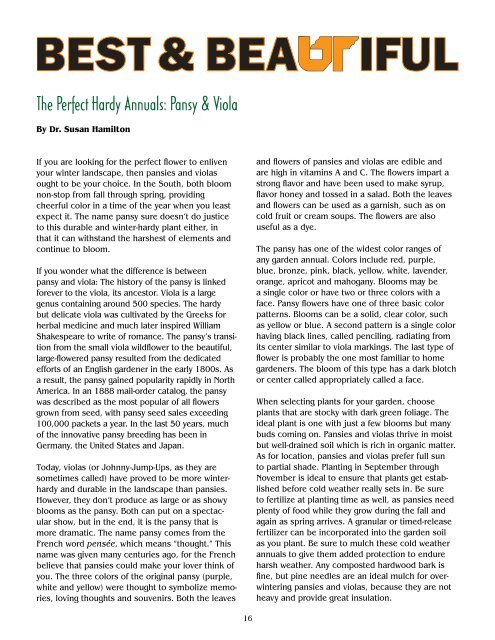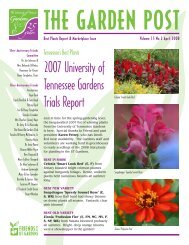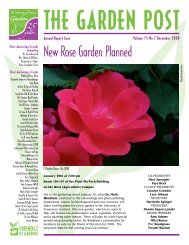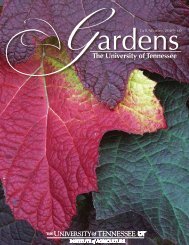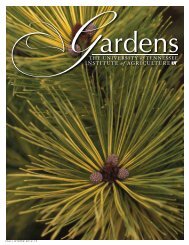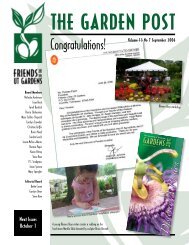October - UT Gardens - The University of Tennessee
October - UT Gardens - The University of Tennessee
October - UT Gardens - The University of Tennessee
Create successful ePaper yourself
Turn your PDF publications into a flip-book with our unique Google optimized e-Paper software.
<strong>The</strong> Perfect Hardy Annuals: Pansy & Viola<br />
By Dr. Susan Hamilton<br />
If you are looking for the perfect flower to enliven<br />
your winter landscape, then pansies and violas<br />
ought to be your choice. In the South, both bloom<br />
non-stop from fall through spring, providing<br />
cheerful color in a time <strong>of</strong> the year when you least<br />
expect it. <strong>The</strong> name pansy sure doesn’t do justice<br />
to this durable and winter-hardy plant either, in<br />
that it can withstand the harshest <strong>of</strong> elements and<br />
continue to bloom.<br />
If you wonder what the difference is between<br />
pansy and viola: <strong>The</strong> history <strong>of</strong> the pansy is linked<br />
forever to the viola, its ancestor. Viola is a large<br />
genus containing around 500 species. <strong>The</strong> hardy<br />
but delicate viola was cultivated by the Greeks for<br />
herbal medicine and much later inspired William<br />
Shakespeare to write <strong>of</strong> romance. <strong>The</strong> pansy’s transition<br />
from the small viola wildflower to the beautiful,<br />
large-flowered pansy resulted from the dedicated<br />
efforts <strong>of</strong> an English gardener in the early 1800s. As<br />
a result, the pansy gained popularity rapidly in North<br />
America. In an 1888 mail-order catalog, the pansy<br />
was described as the most popular <strong>of</strong> all flowers<br />
grown from seed, with pansy seed sales exceeding<br />
100,000 packets a year. In the last 50 years, much<br />
<strong>of</strong> the innovative pansy breeding has been in<br />
Germany, the United States and Japan.<br />
Today, violas (or Johnny-Jump-Ups, as they are<br />
sometimes called) have proved to be more winterhardy<br />
and durable in the landscape than pansies.<br />
However, they don’t produce as large or as showy<br />
blooms as the pansy. Both can put on a spectacular<br />
show, but in the end, it is the pansy that is<br />
more dramatic. <strong>The</strong> name pansy comes from the<br />
French word pensée, which means “thought.” This<br />
name was given many centuries ago, for the French<br />
believe that pansies could make your lover think <strong>of</strong><br />
you. <strong>The</strong> three colors <strong>of</strong> the original pansy (purple,<br />
white and yellow) were thought to symbolize memories,<br />
loving thoughts and souvenirs. Both the leaves<br />
and flowers <strong>of</strong> pansies and violas are edible and<br />
are high in vitamins A and C. <strong>The</strong> flowers impart a<br />
strong flavor and have been used to make syrup,<br />
flavor honey and tossed in a salad. Both the leaves<br />
and flowers can be used as a garnish, such as on<br />
cold fruit or cream soups. <strong>The</strong> flowers are also<br />
useful as a dye.<br />
<strong>The</strong> pansy has one <strong>of</strong> the widest color ranges <strong>of</strong><br />
any garden annual. Colors include red, purple,<br />
blue, bronze, pink, black, yellow, white, lavender,<br />
orange, apricot and mahogany. Blooms may be<br />
a single color or have two or three colors with a<br />
face. Pansy flowers have one <strong>of</strong> three basic color<br />
patterns. Blooms can be a solid, clear color, such<br />
as yellow or blue. A second pattern is a single color<br />
having black lines, called penciling, radiating from<br />
its center similar to viola markings. <strong>The</strong> last type <strong>of</strong><br />
flower is probably the one most familiar to home<br />
gardeners. <strong>The</strong> bloom <strong>of</strong> this type has a dark blotch<br />
or center called appropriately called a face.<br />
When selecting plants for your garden, choose<br />
plants that are stocky with dark green foliage. <strong>The</strong><br />
ideal plant is one with just a few blooms but many<br />
buds coming on. Pansies and violas thrive in moist<br />
but well-drained soil which is rich in organic matter.<br />
As for location, pansies and violas prefer full sun<br />
to partial shade. Planting in September through<br />
November is ideal to ensure that plants get established<br />
before cold weather really sets in. Be sure<br />
to fertilize at planting time as well, as pansies need<br />
plenty <strong>of</strong> food while they grow during the fall and<br />
again as spring arrives. A granular or timed-release<br />
fertilizer can be incorporated into the garden soil<br />
as you plant. Be sure to mulch these cold weather<br />
annuals to give them added protection to endure<br />
harsh weather. Any composted hardwood bark is<br />
fine, but pine needles are an ideal mulch for overwintering<br />
pansies and violas, because they are not<br />
heavy and provide great insulation.<br />
Pansies and violas can be used in a variety <strong>of</strong> ways<br />
in the garden. Nothing is more impressive than<br />
when they are planted en masse. However, if you<br />
use pansies in such a manner, make sure your<br />
spacing is correct. Because pansies and violas are<br />
small plants growing only 8 to 10 inches tall and<br />
wide, they should planted 6 to 8 inches apart.<br />
Spacing plants further apart may be cheaper, but<br />
it will detract from the desired effect. Pansies and<br />
violas are impressive when used in containers or<br />
window boxes, too. <strong>The</strong>y look great if used alone or<br />
in combination with other cool temperature-loving<br />
plants, such as rosemary, thyme, parsley, snapdragon<br />
and dianthus. If you want to have a truly<br />
impressive spring garden, consider inter-planting<br />
tulip or daffodil bulbs with your pansies and violas<br />
both in the landscape or container. Planting the<br />
bulbs between such hardy annuals will bring a<br />
surprise burst <strong>of</strong> color in the spring. And when the<br />
fading bulb’s foliage begins to wither, the pansies<br />
and violas are so colorful that one barely notices<br />
the bulbs’ yellowing foliage. Combining so many<br />
plants into one garden certainly is not the cheapest<br />
garden you’ll ever plant but well worth the price <strong>of</strong><br />
spring enjoyment.<br />
Hundreds <strong>of</strong> varieties <strong>of</strong> both pansies and violas are<br />
on the market, but I recommend you shop for the<br />
series or varieties we have selected from our university<br />
evaluation studies. Results from our winter<br />
trial garden tell us which pansies and violas are the<br />
best for our <strong>Tennessee</strong> gardens. Out <strong>of</strong> 29 different<br />
series <strong>of</strong> pansies and violas tested for landscape<br />
performance and appeal, nine were selected as<br />
outstanding and definitely worth using in your<br />
landscape.<br />
Those selected include:<br />
Pansy series<br />
Matrix<br />
Crystal Bowl<br />
Panola<br />
Fanfare<br />
Viola series<br />
Ultima<br />
Penny<br />
Rebel<br />
Rocky<br />
Sorbet<br />
Be sure to visit our winter variety trail garden just<br />
planted this month. If you find that you are truly taken<br />
and passionate about pansies and violas, you may<br />
want to get involved with the National Viola and Pansy<br />
Society. You can check them out on the Internet at<br />
http://www.sweetviolets.com/nvpspage.htm.<br />
Ultima Radience Red<br />
Panola Deep Blue Blotch<br />
16 17


